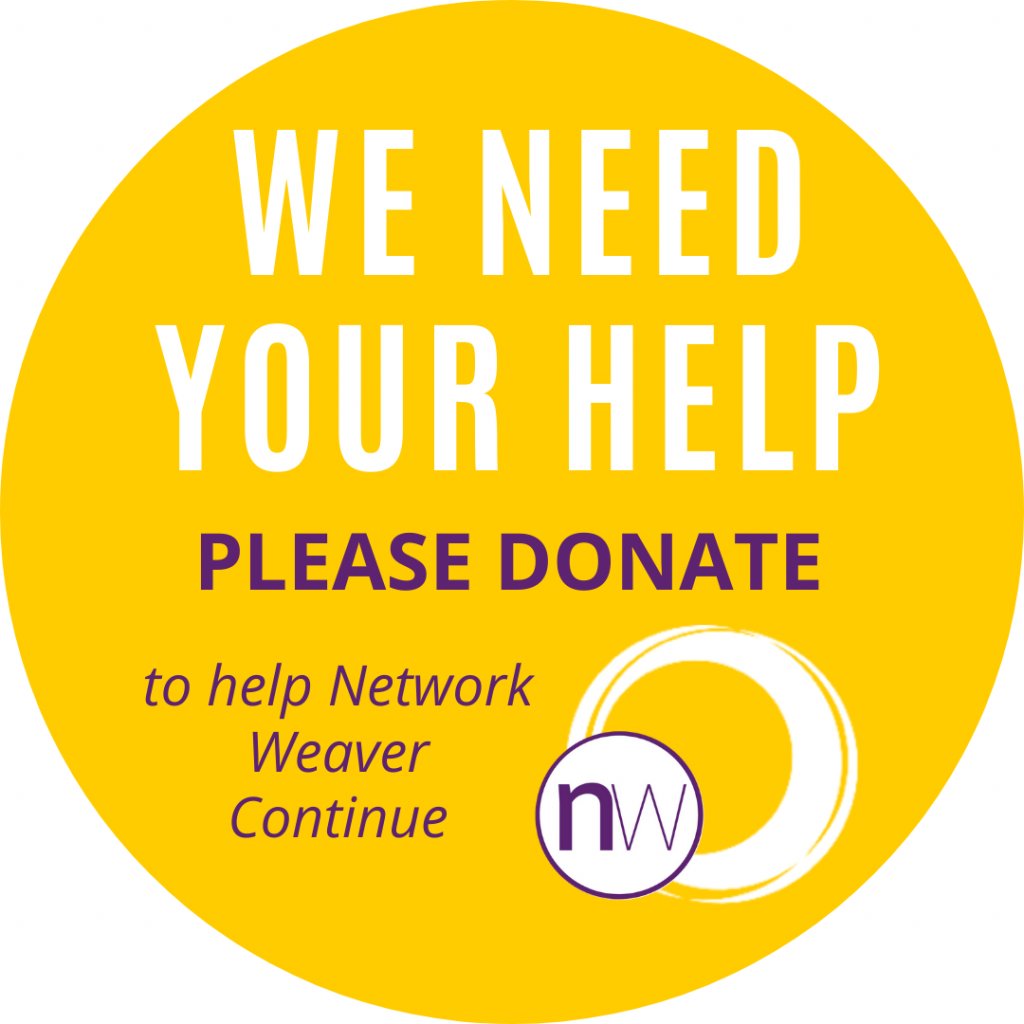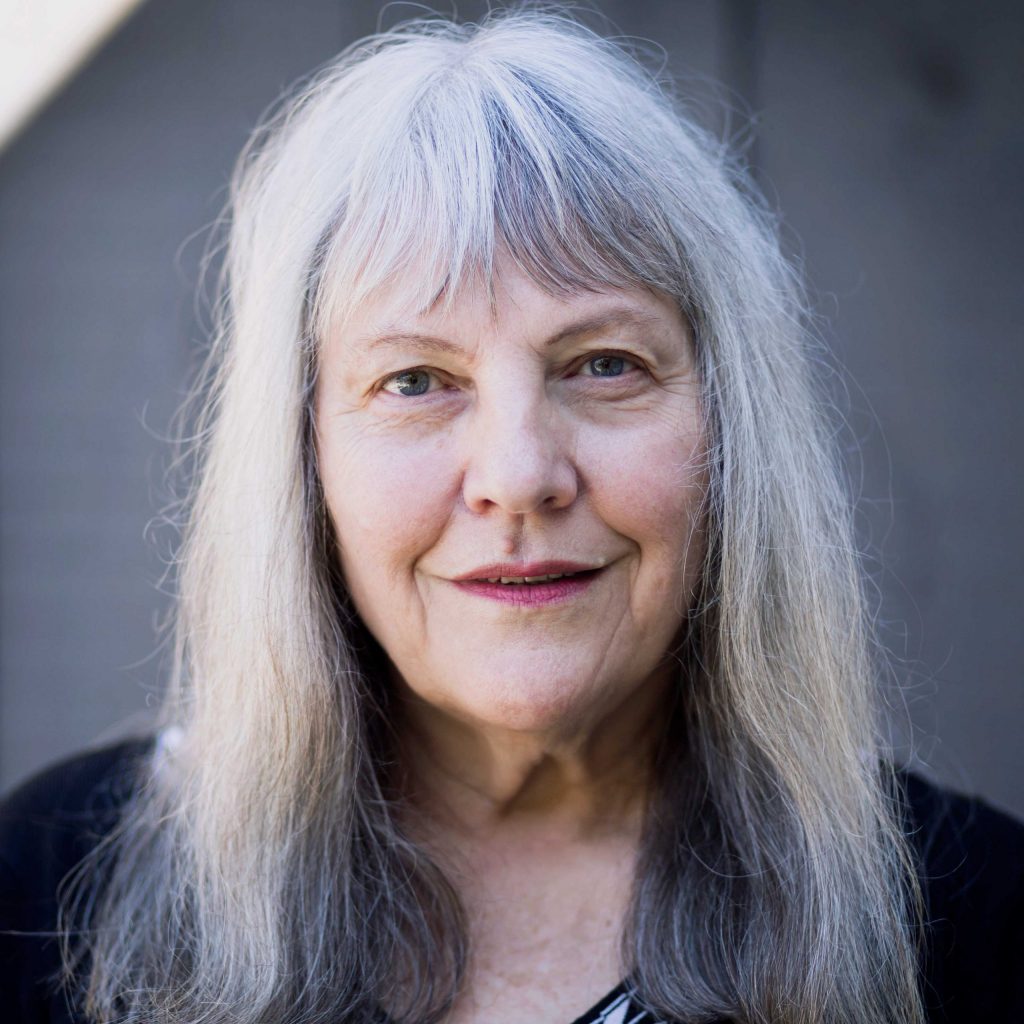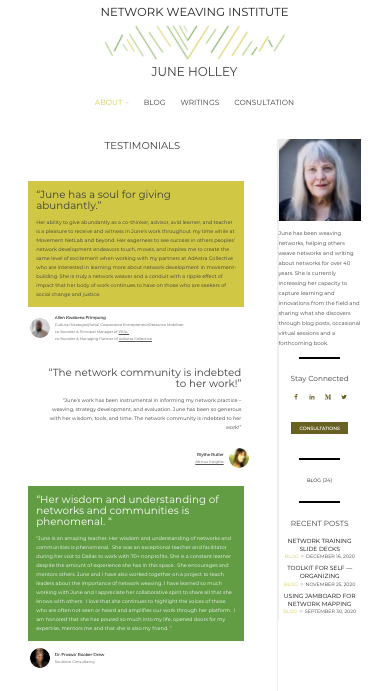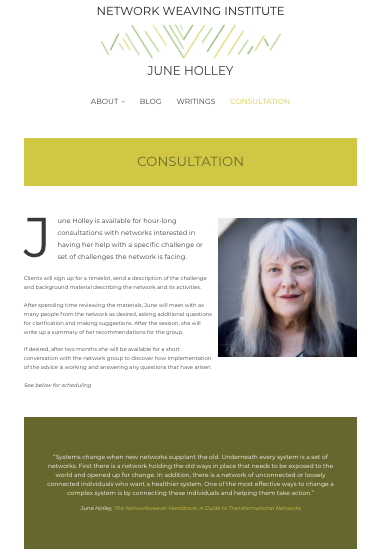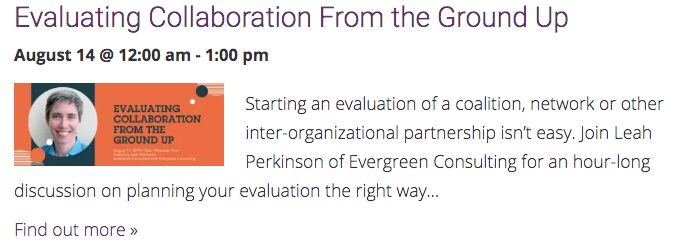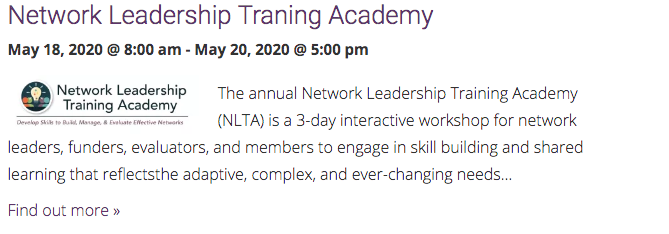How learning ecosystems evolve and how can leaders weave the whole change process
Weaving educational ecosystems in our districts and cities has become one of the greatest worldwide challenges for our systems to enhance learning and equity for the new era. The UNESCO (2020) publication “Education in a Post-COVID World: Nine Ideas for Public Action” indicates that those communities that have responded in an innovative, effective and resilient way to the crisis of COVID-19 are those who had shown greater collaboration between teachers, and between school and community actors. These ideas are also shown by other recent studies on school networks by Daly (2020) Azorín (2020) and Ion & Brown (2020). The reality of this pandemic has reminded us as a species that we are deeply connected to one another (Lancet 2020).
Learning ecosystems are social infrastructure formed by diverse actors that share a purpose, and engage in collaboration to co-design and co-implement innovative responses to existing social and educational challenges. Learning ecosystems provide a new understanding of education from an ecosystemic perspective of actors and their relationships; they challenge traditional organizational boundaries while providing place-based focus on local schools, neighborhoods, cities, or transnational networks; they are based on systemic and cross-sectorial collaboration; and pursue systemic impact (Díaz-Gibson et al., 2020). Thus, one of the most relevant questions in the global educational sphere is how learning ecosystems can be intentionally supported, cultivated and weaved, and how these place based ecosystems grow and evolve over time.
A natural way to approach and better understand learning ecosystems’ development and growth process is to dig into how biological ecosystems change and evolve. Science shows us that collaboration between organisms and species, not struggle for survival that allows ecosystems to evolve and species to truly flourish. As Darwin defended, if humans are the most advanced species it’s because we have the most advanced means of collaborating, and our communities care for the most vulnerable, the sick, the elderly and impoverished. Thus, collaboration is actually a natural and social driver for species survival and for thriving communities.
Ecosystems evolution is drawn byecological succession, understood as the process of change in the species structure of an ecological community over time, where a network of different populations and organisms coexist and interact. The time scale for a biological ecosystem to evolve can be decades -for example, after a wildfire-, or even millions of years. The community begins with relatively few pioneering plants and animals and develops through increasing complexity until it becomes stable or self-perpetuating as a climax community. The engine of succession becomes the impact of established organisms upon their own environments. In other words, intraction among species and within the environment are the drivers of change in all ecosystems.
Colleagues in the NetEduProject have been studying networks, partnerships and ecosystems that enhance learning and equity in the last two decades (Daly, 2010; Riera and Civís, 2008; Díaz-Gibson, 2014; Díaz-Gibson et al, 2017 and 2020). Our learnings show that the development of learning ecosystems and their relational networks become a taugh and complex process that needs time and efforts to be properly cultivated, weaved, and consolidated. Personal relationships require time and intention to emerge and sustain, and their growth involves devoting intentional efforts. With this in mind, Mireia Civís and I have worked on a model to cultivate and weave learning ecosystems in three non linear steps, where we identified some patterns of evolution. Thus, to weave learning ecosystems we need to focus on different conditions depending on its level of maturity:
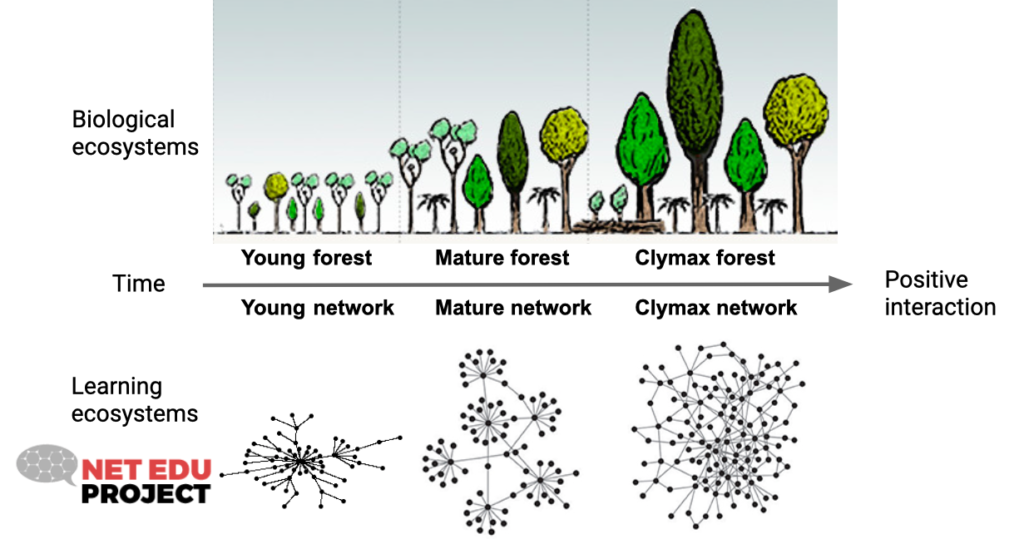
- The initial stage of the ecosystem’s growth is shown in the image as ‘Young network’. Following the idea of ecological succession, ecosystems change depends on the initial conditions found in the social network, and the type and number of actors, and the quantity and quality of relationships draw an initial starting point. At this stage, it is necessary to develop a structural design to cultivate the social foundations that will sustain the whole ecosystem: trust, empathy, recognition of others and collective purpose. It is the moment where members share goals and expectations, adjust rhythms and levels as new relationships are woven. This social capital will sustain the future development of the whole ecosystem of people and organizations, and will become the pillars that pave the way for a new collaborative culture. At this point, collective learning is a priority flow that needs to be planned, at the same time, will be part of the network’s own working culture. Ecosystems can take from one to three years to move into a second stage, and only the construction of solid intangible pillars will allow networks to change and evolve.
- The second stage, named as ‘Mature network’, is more difficult to limit in time as its duration depends on several factors beyond the initial network conditions, such as investment, political support or system coherence. Here, we need to move towards the development and sustainability of social networks, and one of the aims is to consolidate the transition from individual to institutional commitment. It becomes a stage where we want to sustain a collaborative model of action and where we must continue to feed the social intangibles generated. At the same time, new strategies are being sought to assess and increase the impact of collective action. Once networks are weaved, they must come to live and make sense for themselves, they may not depend (or only depend) on external leadership. Also, at this point they must generate clear benefits for their participants according to the established objectives. The design and the structures need to be flexible and readjust to optimize resources to respond to needs and expectations of the people and organizations involved, also drawing clarity on paths for local based outcomes to emerge.
- Finally, the third stage named as ‘Climax network’, is also imprecise in time for the same reasons. In this stage, the ecosystem creates intentional infrastructures for its sustainability beyond personal relationships, establishing institutional agreements, coordination documents, new opportunities for participation, among others. These strategies are aimed to facilitate interaction and self governed initiatives within the network. Here the ecosystem acquires an optimal level of maturity that is evidenced by consolidation of a new culture, where new rules and new ways of doing are practiced in professional and institutional levels. The network organization within the ecosystem in this stage tends to be characterized by a collaborative governance. People are empowered to open new cycles of revision and regeneration in order to create new meaning and new opportunities for individuals and for the collective.
We believe these three fluid and organic steps can inform the type of systemic support needed in the evolution of ecosystems to enhance social capital, learning and equity in our communities and cities across the globe. In the NetEduProject we are ‘hands on’ working on learning and sharing new leadership strategies that can move these social and participatory structures forward over time. As shared in the beginning of this post, science has shown that collaboration is a natural driver for species survival. In this new era we are all embracing, humans and social systems really need to improve our collaborative competences to better take care of one another and create a thriving world for all.
originally published at NET EDU PROJECT
I am a 24-hour learner, passionate collaborator and weaver. Interested in weaving between contexts, disciplines, research and practice to enhance collective impact. I believe that education is a tremendous weapon to change the world.
PLEASE DONATE to help Network Weaver continue in it’s mission to offer free support and resources to networks worldwide.
June Holley's Network Weaving Institute

June Holley has created a new entity, the Network Weaving Institute, so that you can easily track and collaborate in her writing and set up time for consultations with her.
June has been weaving networks, helping others weave networks and writing about networks for over 40 years. She is currently increasing her capacity to capture learning and innovations from the field and sharing what she discovers through blog posts, occasional virtual sessions and a forthcoming book. Topics she will be focusing on in the coming year include:
- a communications system where weavers can support each other and share information
- a place to share what people are learning from their practice,
- a set of resources drawn from emergent practice,
- a set of practices to address inequities and
- a social media strategy to draw more people around the globe into the network weaving network.
Her Practice
In 1981 June discovered complexity science and became intrigued with the process of transformation. How could communities change in ways that would make them good places for everyone?
For the next two decades, she worked with others in Appalachian Ohio to catalyze cascades of network experimentation, observing and documenting the dynamics that enabled many hundreds of people to start and then expand businesses in rural Appalachia. With these newly minted entrepreneurs, she mobilized dozens of area organizations to collaborate, self-organize and create an environment that would help these businesses innovate, expand and work together to create an effective support system for networked entrepreneurs.
After twenty years as executive director of the Appalachian Center for Economic Networks (ACEnet), she stepped down to devote her energies to helping communities around the globe form system shifting, self-organizing networks by training and supporting network weavers and helping new networks form.
The hundred or so network projects she has advised range from local networks to international ones; included networks focused on a specific sector such as food access or health access as well as cross sector initiatives such network leadership networks; reached from small rural networks with a few dozen participants to massive networks with thousands of international participants including the networkweavers network. All recent projects have had a strong equity focus and a commitment to dismantling racism and hierarchy. June has led hundreds of interactive workshops – many of them virtual – on applying a network approach and authored the Network Weaver Handbook and over 20 blog posts.
Current and Future Directions: Network Weaving Institute
In the four decades that June has been supporting networks, they have shifted from being a fringe phenomenon to being the favored way of responding to our complex world. But networks come in all shapes and sizes and we still have only rough guidance in knowing which kinds of networks are best for different situations and how they can be most effectively structured.
During the coming decade, June is stepping back from major consulting projects to focus on taking all that she and others have learned about networks with transformative capacity and writing a series of articles (which may well morph into a book or set of videos). This will be done collaboratively as much as possible – sharing her writings in google docs open to commenting and/or joint editing.
June will also continue to develop materials and modules that can be used by individuals or networks to deepen their understanding of networks.
In addition to writing June will identify a few high leverage cross network efforts (connecting more environmental networks to networks promoting equity and the need to dismantle racism and hierarchy, for example, or helping national networks provide more support to local self-organizing efforts) and will provide opportunities to explore network potentials at no cost. If you know of two or more networks that could benefit by being connected, please let June know!
Finally, June will occasionally offer 60 minute one time advice and exploration sessions to networks who have a specific challenge they would like to discuss. Visit the Consultation page to set up an appointment
Click HERE to Visit Network Weaving Institute

Network Training Slide Decks
We are offering a new section in our Resources section: a set of presentation slide decks that can be used by you for training or sharing with people who want to learn more about networks.
You can edit or mix and match any of the slides into a custom slide deck that will work best for your audience. All the slides are creative commons but please do credit the networkweaver site in your final slide deck.
The first two decks are Network Basics and Network Skills.


If you have presentations that you have created and are willing to share please send to NetworkWeaverManager@gmail.com and we will include in our Resources section.
Blueprints for Change Progressive Organizing and Campaigning Manual
[ap_spacing spacing_height="15px"]
The Blueprints for Change Progressive Organizing and Campaigning Manual is a compilation of all guides produced through Blueprints for Change up till November 2019 in its current edition. This PDF doc, which is full of internal links for easy navigation, also contains information on the project, its policies, values and a full list of all contributors.
Blueprints for Change is very happy to offer this bundle of hard work and collective wisdom to progressive organizers and campaigners everywhere! This Manual represents two years’ worth of work and the contributions of over 100 campaign innovators and groups.
What you’ll find within:
- 14 detailed how-to guides on cutting-edge approaches to progressive organizing and mobilizing
- totaling over 180 pages
- field experiences and insights of over 100 progressive campaign innovators from across the world!
CLICK HERE to download the manual.
[ap_spacing spacing_height="15px"]
Network Weaver Job Description
[ap_spacing spacing_height="10px"]
Many networks are hiring network weavers and/or network coordinators or managers. I pulled together two excellent examples of job descriptions, which are detailed below. You can also access them through the resource page as a free resource so you can email them to your board or hiring committee.
[ap_spacing spacing_height="40px"]
Below is a network weaver job description from a network I’m working with, the Resonance Network. What would you add or change?
[ap_spacing spacing_height="15px"]
[ap_spacing spacing_height="20px"]
Network Weaver
[ap_spacing spacing_height="20px"]
Core Responsibilities
- Develop a plan to align and weave the various parts of the Network – individuals, collectives, communities, projects and actions -- routinely connecting parts and people across groups and projects
- Catalyze and coordinate network-wide activities in alignment with current strategic priorities
- Support all staff, consultants and network participants to have a basic understanding of network approaches, network values and basic network weaving skills
- Facilitate integration of network weaving perspective and practice throughout network activities
- Coordinate pool of network facilitators -- connecting them to collaborative and/or self-organized projects seeking their support and organizing them into a community of practice
- Design and implement engagement ladders, providing a spectrum of opportunities for network participants to get involved in network activities
- Catalyze and support self-organizing among network participants
- Use network maps to identify opportunities for connections among individuals and projects to better connect the network
[ap_spacing spacing_height="20px"]
Desired Qualities/Experience/Skills
- Experience in building and nurturing networks, coalitions, or communities of practice that encompass a range of perspectives, cultures, and backgrounds, including experience growing online/offline community through art, mobilization, and/or organizing
- Proficiency in network mapping tools and analysis of maps
- Comfortable working in a quick-paced environment to help develop the weavers and facilitators to support network development.
- Open to experimentation, learning, and adjustments along the way; ability to push through ambiguity to deliver results
- Deep passion for building and supporting relationships; skilled in lifting up the work of others, often in a behind-the-scenes way
- Strong project-management skills including great attention to detail, organizational skills, and the ability to manage projects with many moving parts
- Superb written and verbal communication skills
- Comfortable flying in the cloud (Google Drive, Slack, Salesforce, Dropbox, etc.), and proficiency with or willingness to learn Kumu or other network-mapping tools
- Ability to work independently and think creatively about how to leverage the resources at your disposal
- Strong interpersonal skills, including ability to communicate openly and directly with co-workers and community members
- Demonstrated commitment to racial, social, and economic justice
- People of color, immigrants, queer, women, transgender, non-binary folks encouraged to apply
[ap_spacing spacing_height="45px"]
Below is another description, this time for a Network Manager or Coordinator. From the Santa Cruz Mountains Stewardship Network developed by Converge.
[ap_spacing spacing_height="15px"]
[ap_spacing spacing_height="20px"]
Network Manager
[ap_spacing spacing_height="20px"]
Primary Responsibilities
The Network Manager creates, cultivates, and ensures high quality relationships and collaborations that advance the mission of the network. Primary responsibilities are to:
Convene the Network
- Help design and facilitate network convenings
- Organize convening logistics, including meeting locations, catering, materials, reminders, etc.
Catalyze the Network
- Support new member onboarding
- Facilitate connections between network participants
- Support network participants to more deeply connect their organization with the work of network
Coordinate the Network
- Coordinate and join monthly Core Team & Impact Team meetings and calls, identifying points of intersection and bottlenecks, and helping to connect network participants with other network members or regional leaders for assistance or support
- Track project progress, outcomes, bottlenecks
- Capture key takeaways and next steps from convenings
- Regularly update the network dashboard and provide monthly updates
- Manage network finances and budget
- Perform site visits to stay aware of network projects and stewardship collaborations between participants
- Coordinate with other regional networks to identify points of intersection
- Maintain the network’s technological infrastructure (Basecamp, Google Docs) and keep them up to date
Communicate with and for the Network
- Function as primary point of contact for the network internally and externally
- Connect with each individual participant of the network to understand their work, their organization, how the network can support the participant and their organization in service of shared goals as outlined in the MOU, and how the participant and their organizations can support and more strongly engage with the network
- Keep network conversations vibrant and alive
- Reach out to drifting participants and find creative ways to re-engage them in the network
[ap_spacing spacing_height="15px"]
Resource the Network
- Support and lead network fundraising efforts with the Resource Impact Team and the Core Team
- Work with network members to identify and secure in-kind contributions, including meeting locations, transportation, catering, materials, etc.
[ap_spacing spacing_height="15px"]
Essential Skills
- Strong interpersonal abilities, with a willingness to cross boundaries and work with diverse people
- Solid facilitation and presentation skills
- Exceptional attention to detail, super organized, great time management
- Dynamic problem solving skills
- Comfortable with technology
Personal Characteristics
- Deep passion for the mission
- Personal humility, servant leader, network entrepreneur
- Knows how to ask for and receive help
- Proactive, self-starter, loves to take initiative with an urgency to get the job done
- Understands the big picture and larger context of the work, systems thinker
- Ability to see all sides of an issue
- Patient, stays cool under pressure
- Great sense of humor, ability to see the positive
- Loves nature and the region
Check Out These Network Weaving Events!
Did you know we have an Events Page? We publish Network Weaving Events hosted by our Network Weaver Consultants and other amazing weavers. Below are some upcoming webinars, meetings and trainings.
[ap_spacing spacing_height="35px"]
[ap_spacing spacing_height="35px"]
If you have an event you'd like us to publish, email: info@dev.networkweaver.com.
Featured Image from unesco.org
How do we practice collective leadership when some parts of the leadership development practice feel individual?
Leadership Learning Community has spent a great deal of time and energy encouraging leadership funders and practitioners to expand and evolve their thinking on the very concept of leadership. To think about leadership not simply using what is called the “lone hero” model or lens. When the story of social change is told, it usually involves a few brave men, and occasionally women, who through grit, determination, and perhaps a superpower or two, save the day by individually ushering in change. This approach often excludes many from participating, upholds hierarchical, and often oppressive systems, and is frequently ahistoric, invisiblizing all of the non-household names, often less-privileged folks, who labored to make change possible.
Instead, LLC has supported efforts to think about leadership in more expansive, accessible, equitable, inclusive and democratic ways. Networked leadership is one example, creating a broad base of leadership rather than one leader to lead them all.
But the actual practice of inclusive and networked leadership is challenging. Often, supports are provided to or experienced by individual people, not whole communities, networks or demographic groups simultaneously. Smart and effective leadership processes encourage participants to engage in personal internal reflection, to build authentic relationships with other individuals, attend skills-building training sessions where a person individually chooses to show-up, etc; So how do we practice collective leadership when some parts of the leadership development practice feel individual?
Community Organizers have actually identified many ways to address this complicated challenge, but lately, I find myself thinking more and more about the following 3 approaches.
[ap_spacing spacing_height="25px"]
Building Collective Leadership: 3 Lessons from Community Organizing
[ap_spacing spacing_height="20px"]
1. Grounding Leadership in Purpose, Values and your Vision of the world you wish to create:
In a community organizing context, directly impacted people gather together to change the conditions in their communities: e.g. a dangerous intersection, economic exploitation, inequitable education funding, police brutality, or unsafe drinking water. An organizing effort is guided by collective need and collective purpose, rather than the pursuit of simply a personal change, although significant transformative personal growth certainly occurs. What is important to note is that those involved in Social Justice organizing aren’t only attempting to change the material conditions in communities, they are also attempting to refashion their communities in accordance with a more just vision of the world. I’m not suggesting that organizing spaces don’t grapple with individualism, but it's much easier to remove ego from the equation when the conversation is about a collective purpose to change the world we share, rather than individual benefit.
[ap_spacing spacing_height="15px"]
2. Embed collectivist and collaborative approaches into the Leadership model:
Community organizers talk and think about power a lot, particularly asymmetrical power. Building collective, rather than individual power, as a way to counter gross power asymmetries is a core concept of organizing. Consequently, collaborative action is both an organizing value and strategy. This doesn’t mean that individual growth and personal relationships aren’t also important, part of the work of organizing is appreciating the individuals within a collective. However, when a community organizer works to support the leadership of a community member, together they deeply explore the greater capacity of people working together. The popular chant, “The people united will never be defeated,” clearly articulates this concept. This is different from a concept of leadership which suggests that if more individual people develop their own skills or abilities, a problem will be solved.
[ap_spacing spacing_height="15px"]
3. Political education and consciousness-raising:
Effective community organizers create space for people to ask “why” over and over again. Sometimes folks are able to ask “why”, using the circumstances of their own lives as the study material. For example, domestic workers facing exploitation or tenants experiencing yet another winter without heat can ask not only “how can we stop the mistreatment,” or “how do we get heat,” but “Why are our working or living conditions the way they are?”; exploring who is harmed, who benefited, as well as the systems and structures which perpetuate those conditions.
Another effective model is to take a fairly well known historical example. A common example is the Montgomery Bus Boycott, and moving beyond what is common knowledge. In most Black History Month lesson plans, we learn about the Boycott through the Lone Hero lens. But by digging more deeply into the actors (including those overlooked by history books), conditions, leadership development practices, and strategic decision-making processes, we gain a better understanding of the full array of people who contributed.
This practice of excavating both the history and root causes of social conditions is also relevant for leadership development. In addition to “why”, community organizing also encourages people to ask “what”; namely, what would happen if we got together to demand something different? I recently heard Sally Leiderman encourage a group of leadership practitioners to question if their work upholds or interrupts the status quo, or something in between. This, for me, is the most salient question. What would happen if we supported leadership differently, leadership for equity, community building, and love? Exploring what we know about leadership, why we know it and how this understanding shapes our world could help us reimagine new ways of supporting leadership for a more just world.
______________________________________________________________________________
1Shout out to the amazing current and former trainers at the Center for Community Leadership from whom I have stolen different ways of doing this: Susanna Blankley, Joan Minieri, Angelica Otero, Zahida Pirani, Krystal Portalatin, and Hector Soto
Originally published at Leadership Learning Community on 5.6.19
Lista de verificación Network Weaver
[ap_spacing spacing_height="15px"]
A spanish/english version of the Network Weaver Checklist, translated by Ulises Aguila.
[ap_spacing spacing_height="15px"]La Lista de control de Network Weaver se ha revisado de la versión del Manual del NW y en formato pdf para facilitar la impresión.
[ap_spacing spacing_height="15px"]Network Weaver Checklist is revised from the NW Handbook version and in pdf format to make it easy for you to print. This checklist is great to give to people in your network at a face-to-face gathering. [ap_spacing spacing_height="15px"]
For the english only version click here.
[ap_spacing spacing_height="15px"]
Network Weaver Virtual Cafe No. 3
[ap_spacing spacing_height="20px"]
THE PURPOSE of this monthly series of virtual cafes serves to deepen the learning community of network weavers by:
[ap_spacing spacing_height="20px"]
- learning about and supporting each other in our practice of network weaving [ap_spacing spacing_height="10px"]
- strengthening relationships and connecting capacities [ap_spacing spacing_height="10px"]
- attract more abundance for network weaver [ap_spacing spacing_height="20px"]
An open HOSTING TEAM designs, facilitates and documents these cafes. Hosts choose various formats they deem appropriate. If you want to co-facilitate, join the open chat for hosts
[ap_spacing spacing_height="25px"]
THE PROGRAM will be updated a few days ahead of each cafe:
[ap_spacing spacing_height="10px"]
- Learning wishes - what and how do we want to learn about network weaving? [ap_spacing spacing_height="10px"]
- Open Space - learning exchanges about topics you want to learn about[ap_spacing spacing_height="10px"]
- Peer Assist - supporting each other with current challenges[ap_spacing spacing_height="10px"]
For those who can only join for one hour, you can leave after the Open Space.
[ap_spacing spacing_height="25px"]
THE DETAILS:[ap_spacing spacing_height="10px"]
- FIND THE FACEBOOK EVENT LISTING HERE [ap_spacing spacing_height="10px"]
- ZOOM: https://zoom.us/j/158170326 [ap_spacing spacing_height="10px"]
- TIME: Thursday, April 4, 2019 at 4 PM – 6 PM UTC+01 (Find the time in your time zone) [ap_spacing spacing_height="15px"]
*** Please help energize this community of practice and the Networking Weaving Virtual Cafe call coming up on April 4th by taking a few minutes to participate this brief survey for this collaborative online process. The goal is to engage via the Codigital platform now through April 1, in order to identify and rank a set of powerful questions that we can consider during our call as well as via this Facebook group. This is also a chance to learn about Codigital, which I have found to be a really valuable, easy-to-use tool for group ideation.
[ap_spacing spacing_height="20px"]
DOCUMENTATION of previous cafe's can be found and edited HERE
[ap_spacing spacing_height="25px"]
by Adrian Röbke, Ben Roberts, A Keala Young, Tim Strasser, Jim Best, Nenad Maljković
Network Weaving
Network weaving plays a critical role in community development strategies of all kinds. In the Connected Community Approach, networks of residents, organizations and institutions are central to creating place-based systems change.
In this video local community builders share their stories, skills and insights as they explore the tremendous impact network weaving can have on the health and vitality of community.
For more examples of the Connected Community Approach in action, please visit www.thestorefront.org
For more tools and ideas on how to create your own connected community, please visit www.connectedcommunities.ca



